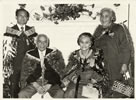Tokomaru and Tahatuna
The earliest Taranaki canoe tradition says that conflict arose in Hawaiki when a party of spear-makers, led by Tūpenu and employed by the chief Manaia, molested Manaia’s wife, Rongotiki. Manaia’s people attacked and killed the workmen. Retribution followed, during which several of Manaia’s people were killed. Manaia took the Tokomaru canoe, with Rākeiora as his navigator, and left. The canoe arrived off the North Island’s east coast, sailed northward past North Cape or was carried across the Te Tō Waka portage at Auckland, and then went south to Taranaki, landing at Tongapōrutu.
A second Taranaki account says that Manaia commanded a vessel named Tahatuna and that Whata was the commander or builder of Tokomaru. In this account, Rākeiora and Tama-ariki were the navigators, and the canoe landed at the Mōhakatino River. Tama-ariki is the ancestor from whom the Ngāti Tama people take their name. Rākeiora was deified after his death as a god of the kūmara (sweet potato).
Kurahaupō
The Taranaki tribes say that Te Moungaroa was the captain of Kurahaupō and that the canoe was wrecked in Hawaiki, or on Rangitāhua, an island in the middle of the sea, and that the crew were brought to Aotearoa on the Mataatua or Aotea canoes. The Rangitāne tribe of the Manawatū, Wairarapa and Hawke’s Bay regions say that Whātonga was the captain of this canoe and that it was wrecked at Māhia Peninsula. Ngāti Apa of the Rangitīkei River agree that the canoe was wrecked at Māhia, but say that the captain was Ruatea. Whātonga is known for a longer inland journey, exploring the region from Māhia to Wellington, across Cook Strait to the top of the South Island, and then up the west coast of the North Island as far as the Rangitīkei River. This canoe is also known in Northland.
Aotea and Te Rīrino
The Aotea left Hawaiki after a dispute between its captain, Turi, and a chief, Uenuku. Uenuku took offence at an offering from Turi and killed Turi's son Pōtikirōroa. In the reprisals which followed, Turi killed Uenuku's son Awepōtiki, cooked his heart and placed it in another offering to Uenuku, who unwittingly ate it. When he realised this, Uenuku assembled a large force against Turi. Turi procured Aotea from his father-in-law, Toto, and sailed forth accompanied by another canoe, Te Rīrino, which was lost in the Tasman Sea. Aotea landed in a small bay called Hawaiki-iti in Aotea Harbour, just north of Kāwhia.
Leaving the canoe behind, the crew journeyed south on foot, naming nearly every river and stream they crossed after some incident connected with Turi. Turi's party finally reached and settled the area around the Pātea River, so named because it was where his people threw down their burdens (pātea). Rongorongo, Turi’s wife, planted kūmara (sweet potato) there. His daughter, Tāneroroa, married Uenuki-puanaki and their descendants settled on the northern side of the Pātea River, where they became Ngāti Ruanui. The descendants of Turi’s son, Tūranga-i-mua, settled on the southern banks of the Pātea River and southward to Waitōtara and the Whanganui River, where they became part of the Ngā Rauru tribe. One famous phrase associated with this canoe is ‘E kore e ngaro te kākano i ruia mai i Rangiātea’ (I will never be lost, for I am the seed that was sown at Rangiātea). Many people believe this refers to the island of Rangiātea, near Tahiti.
Kahutara, Taikōria and Ōkoki
According to one Taranaki account, some of the earliest inhabitants of New Zealand landed at Ngāmotu near New Plymouth on three canoes, Kahutara, Taikōria and Ōkoki, which were commanded by Maruiwi, Ruatāmore and Taitāwaro respectively. Three other chiefs on these canoes are also remembered: Pohokura (a younger brother of Taitāwaro), Pananehu and Tāmaki. The descendants of the three crews were later known as Te Tini-o-Maruiwi, Te Tini-o-Ruatāmore, Te Tini-o-Taitāwaro, Te Tini-o-Pananehu, Koaupari and Te Wīwini.
Pangatoru, Motumotuahi, Te Rangiuamutu, Te Wakaringaringa and Te Kōhatuwhenua
The traditions of the Taranaki tribes of Ngāti Ruanui and Ngā Rauru name at least five other ancestral leaders, and the canoes they captained. They are:
- Rakeiwānangaora of Pangatoru
- Puatautahi of Motumotuahi
- Tamatearokai of Te Rangiuamutu (this canoe is sometimes called Tairea)
- Māwakeroa of Te Wakaringaringa
- Taikehu of Te Kōhatuwhenua.
